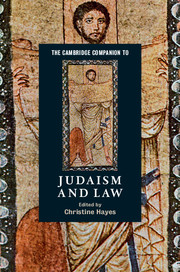25 results
The parasitoid complex of diamondback moth, Plutella xylostella (Linnaeus) (Lepidoptera: Plutellidae), in Canada: impact and status
-
- Journal:
- The Canadian Entomologist / Volume 154 / Issue 1 / 2022
- Published online by Cambridge University Press:
- 25 January 2022, e12
-
- Article
-
- You have access
- Open access
- HTML
- Export citation
Adi Ophir and Ishay Rosen-Zvi. Goy: Israel's Multiple Others and the Birth of the Gentile. Oxford: Oxford University Press, 2018. viii + 333 pp.
-
- Journal:
- AJS Review / Volume 44 / Issue 1 / April 2020
- Published online by Cambridge University Press:
- 14 April 2020, pp. 190-192
- Print publication:
- April 2020
-
- Article
- Export citation
Roman and Jewish Law: Looking for Interaction in all the Right Places
-
- Journal:
- Law and History Review / Volume 37 / Issue 4 / November 2019
- Published online by Cambridge University Press:
- 06 November 2019, pp. 955-959
- Print publication:
- November 2019
-
- Article
- Export citation
A qualitative study of patient and provider perspectives on using web-based pain coping skills training to treat persistent cancer pain
-
- Journal:
- Palliative & Supportive Care / Volume 16 / Issue 2 / April 2018
- Published online by Cambridge University Press:
- 07 March 2017, pp. 155-169
-
- Article
- Export citation

The Cambridge Companion to Judaism and Law
-
- Published online:
- 23 February 2017
- Print publication:
- 17 February 2017
Index
-
- Book:
- The Cambridge Companion to Judaism and Law
- Published online:
- 23 February 2017
- Print publication:
- 17 February 2017, pp 421-424
-
- Chapter
- Export citation
Copyright page
-
- Book:
- The Cambridge Companion to Judaism and Law
- Published online:
- 23 February 2017
- Print publication:
- 17 February 2017, pp vi-vi
-
- Chapter
- Export citation
Contents
-
- Book:
- The Cambridge Companion to Judaism and Law
- Published online:
- 23 February 2017
- Print publication:
- 17 February 2017, pp vii-viii
-
- Chapter
- Export citation
Acknowledgments
-
- Book:
- The Cambridge Companion to Judaism and Law
- Published online:
- 23 February 2017
- Print publication:
- 17 February 2017, pp xi-xii
-
- Chapter
- Export citation
Part I - Law as Constitutive of Biblical and Premodern Jewish Religious Expression
-
- Book:
- The Cambridge Companion to Judaism and Law
- Published online:
- 23 February 2017
- Print publication:
- 17 February 2017, pp 17-186
-
- Chapter
- Export citation
Contributors
-
- Book:
- The Cambridge Companion to Judaism and Law
- Published online:
- 23 February 2017
- Print publication:
- 17 February 2017, pp ix-x
-
- Chapter
- Export citation
3 - Law in Classical Rabbinic Judaism
- from Part I - Law as Constitutive of Biblical and Premodern Jewish Religious Expression
-
-
- Book:
- The Cambridge Companion to Judaism and Law
- Published online:
- 23 February 2017
- Print publication:
- 17 February 2017, pp 76-127
-
- Chapter
- Export citation
Part II - Enlightenment, Emancipation, and the Invention of Jewish “Religion”
-
- Book:
- The Cambridge Companion to Judaism and Law
- Published online:
- 23 February 2017
- Print publication:
- 17 February 2017, pp 187-314
-
- Chapter
- Export citation
Part III - Judaism and the Secular Jewish State
-
- Book:
- The Cambridge Companion to Judaism and Law
- Published online:
- 23 February 2017
- Print publication:
- 17 February 2017, pp 315-420
-
- Chapter
- Export citation
Introduction: Can We Even Speak of “Judaism and Law”?
-
-
- Book:
- The Cambridge Companion to Judaism and Law
- Published online:
- 23 February 2017
- Print publication:
- 17 February 2017, pp 1-16
-
- Chapter
- Export citation
From the Editors
-
- Journal:
- AJS Review / Volume 39 / Issue 2 / November 2015
- Published online by Cambridge University Press:
- 13 November 2015, p. 265
- Print publication:
- November 2015
-
- Article
-
- You have access
- HTML
- Export citation
From the Editors
-
- Journal:
- AJS Review / Volume 39 / Issue 1 / April 2015
- Published online by Cambridge University Press:
- 12 May 2015, p. 1
- Print publication:
- April 2015
-
- Article
-
- You have access
- HTML
- Export citation
The Résumé-Development Process and Its Impact on Job-Search Behaviour
-
- Journal:
- International Journal of Disability Management / Volume 8 / 2013
- Published online by Cambridge University Press:
- 23 January 2013, e2
- Print publication:
- 2013
-
- Article
-
- You have access
- HTML
- Export citation
Statement from the Incoming Editors
-
- Journal:
- AJS Review / Volume 36 / Issue 2 / November 2012
- Published online by Cambridge University Press:
- 20 November 2012, p. 185
- Print publication:
- November 2012
-
- Article
-
- You have access
- HTML
- Export citation
Cost utility of behavioural activation delivered by the non-specialist
-
- Journal:
- The British Journal of Psychiatry / Volume 199 / Issue 6 / December 2011
- Published online by Cambridge University Press:
- 02 January 2018, pp. 510-511
- Print publication:
- December 2011
-
- Article
-
- You have access
- HTML
- Export citation

